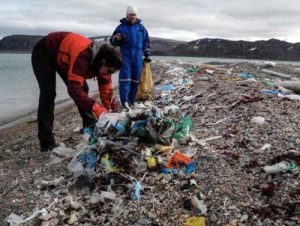The Arctic Marine Litter expedition has begun!
Marine litter comes in all shapes and sizes: it can be small or large. It can be generated by tourism and industry from sources such as shipping and fishing. In a densely populated country such as the Netherlands, in which rivers transport litter to the sea, tourists leave litter on the beach and ships dump litter in the sea, it is no surprise that we find masses of litter covering our beaches each year.

Expedition 2015 – Svalbard
However, this does not mean that more remote regions such as the Arctic are pristine. Some beaches are literally strewn with large pieces of litter such as nets, buoys, household plastics and other waste. This raises all kinds of questions. How can so much litter end up here? What is it exactly? How does it find its way into the ocean? And where does it come from? One could also wonder whether there is a link to certain economic activities in Svalbard, or whether the litter has come from further afield. If so, from where and how?
Seeking out the origins of the plastic soup
Unfortunately, there is still little information on the amount, type and source of this litter. But if one is to implement solutions in terms of policy or in the relevant sectors, or if we would like to know more about the effects of these actions, we must be able to access qualitative and quantitative information. This was the starting point for the first part of the survey we embarked on last Saturday.
We boarded the expedition vessel ‘Ortelius’ by Oceanwide Expeditions on Saturday. Over the next few weeks, this vessel will take us to beaches on the island of Jan Mayen and to Svalbard. Once ashore, along with the other passengers on the Ortelius, we will monitor and gather litter on all the beaches we are able to visit during our cruise. In order to collect as much information as possible. These monitoring activities will be based on the OSPAR guideline for monitoring marine litter. Thereby the data can be compared internationally.
Marine litter on the Arctic beaches
Jan Mayen – a little-known, volcanic island located between Greenland, Iceland and Svalbard in the Atlantic Ocean – will be the first stop on the expedition. Given that only a handful of vessels pass by, let alone moor here each year, this cruise is a unique opportunity to research marine litter.
We hope to arrive on Jan Mayer on Friday 26 May. However, it remains to be seen whether we will be able to conduct research there. As the island has no harbour, we will only be able to reach the beaches in our zodiacs if the weather conditions are good. We will be posting regular blog updates over the coming weeks to share our experiences and keep you updated on the results.
Until the next stop!
The expedition and the blog Arctic Marine Litter is a collaboration between Wouter Jan Strietman and Eelco Leemans


[…] Blog 1 “The Arctic Marine Litter expedition has begun!” […]
[…] Blog 1 “The Arctic Marine Litter expedition has begun!“ […]